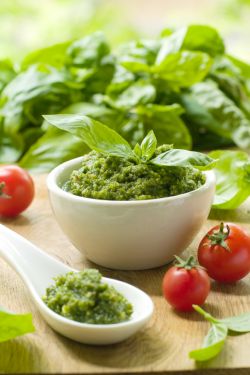 Pesto sauce originated in Genoa in the Ligurian region of northern Italy. Traditionally, it consists of crushed garlic and pine nuts blended with olive oil, Parmigiano-Reggiano and Pecorino cheeses. In Roman times it is believed that the notion of combining oil, herbs and nuts with cheese—a la pesto—was imported from Africa. However it went down, the world is a tastier place as a result. Obviously, pesto makes the perfect accompaniment to any fresh pasta, but it also goes great with roasted meats and toasted bread.
Pesto sauce originated in Genoa in the Ligurian region of northern Italy. Traditionally, it consists of crushed garlic and pine nuts blended with olive oil, Parmigiano-Reggiano and Pecorino cheeses. In Roman times it is believed that the notion of combining oil, herbs and nuts with cheese—a la pesto—was imported from Africa. However it went down, the world is a tastier place as a result. Obviously, pesto makes the perfect accompaniment to any fresh pasta, but it also goes great with roasted meats and toasted bread.
Perfect pesto relies on texture as much as flavor. Whipping up a pesto in a food processor can be done in two minutes. But the finished product is a completely homogenized emulsion or paste with little definition between ingredients. It will taste all right but the best, most satisfying and truly authentic pesto comes when using traditional methods. That means eschewing electricity and sticking with a mortar and pestle or blade and cutting board. With a mortar the idea is to ground the ingredients in a circular motion rather than pounding and bruising them. You’re making a sauce that dates back to Roman times—a little finesse is key.
If you’re using a knife or a mezzaluna, make sure the blades are sharp. Dull blades will bruise the basil and make it unappetizingly dark. The Italian technique is to chop a bit, add some ingredients, chop some more and so on. This way the ingredients get broken down into different gradations, contributing to the overall texture. When pasta gets dressed with hand-made pesto the tiny flecks of basil separate from the olive oil in places, giving you textural definition between the ingredients. This allows the bright flavors to pop in ways they don’t when simply whipped into a blob. If you love pesto, than this is the way to really make it shine.
The original—basil, pine nuts, cheese and olive oil—pesto “Genovese” is tough to beat, but that shouldn’t prevent you from trying out other amazing versions like: arugula pesto, sun-dried tomato pesto, pea pesto, spinach pesto, mint pesto and walnut pesto to name a few. With any version, go easy with the salt—the cheese contains plenty. Pesto can be kept in the refrigerator for up to a week, but it really peaks when served fresh. If storing, pour a thin layer of olive oil over the top to prevent discoloration.
Classic pesto is a four-ingredient masterpiece. It’s ridiculously easy, so versatile and incredibly delicious. Buying pre-packaged pesto from a store is not only expensive, but also akin to throwing in the towel. So don’t give up—get chopping.